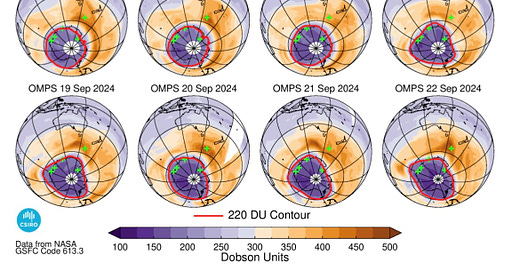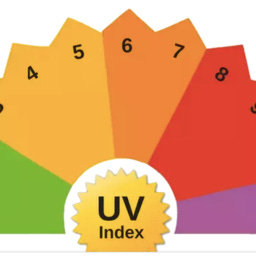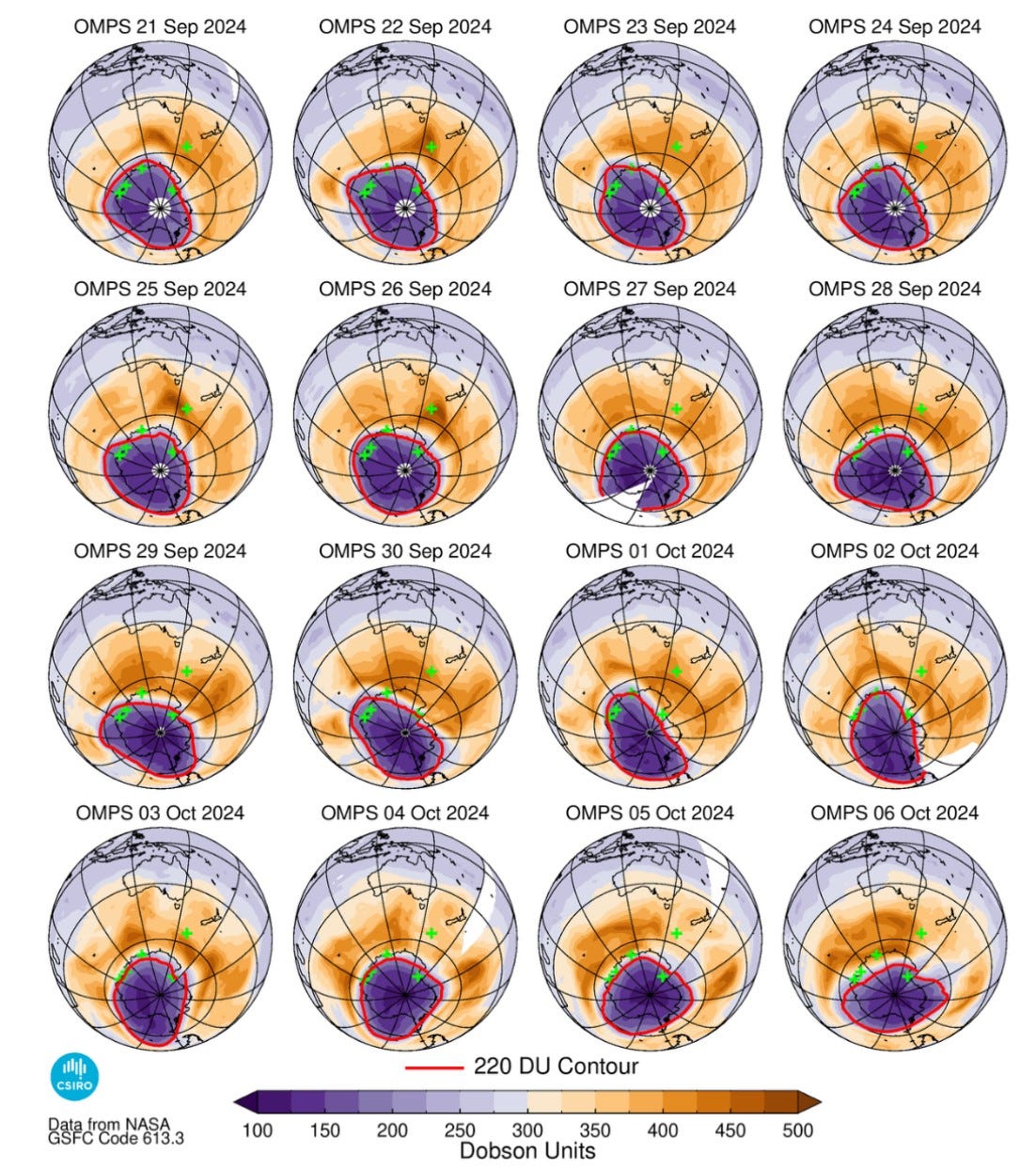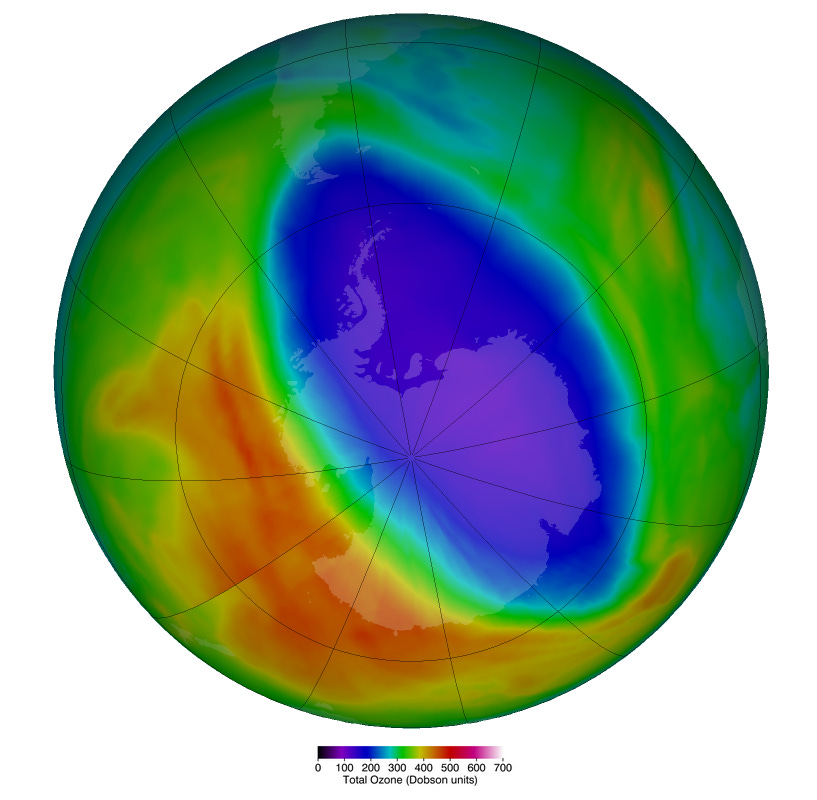Low ozone means high UV - all other factors being equal.
The string of daily images below illustrates the development of this spring’s Antarctic ‘ozone hole’ over the period 7 to 22 September. Unlike the usual NASA images, they were produced for a report from Australia’s CSIRO, so are centred on the Australasian sector to give a nicer than usual perspective for us. The red line shows the limit of the ozone hole, as defined by the 220 DU contour, and the green crosses show the high-latitude sites where ozone is measured from the ground by agencies in Australasia. The global average ozone is about 300 DU, so areas in blue/grey shades have less ozone than average while brown-shaded regions have more. The white circle over the south pole, which diminishes in size over the spring period, is the area where ozone retrievals weren’t possible with the satellite instrument because there was no sunlight.
And below are the corresponding images for the following three weeks, which includes the ‘business end’ of this year’s event. Depletion was most severe on 28 September, when the area of the ozone-hole was 22 million square kilometres - more than twice the size of the USA. On the same day, the minimum ozone column amount was 107 DU (compared with an all-time minimum of 92 DU in 1994) and the mass of ozone below ‘normal’ was nearly 29 million tons.
That’s a lot of ozone missing. But, overall, it’ll be a very ‘average’ year as far as ozone holes go over the period 1980 to the present.
When giving public talks I like to emphasise that - despite public hysteria - at the time of the ozone hole, there’s no country with more overhead ozone than right here where I live. Actually, there’s usually even more ozone over the ocean just to the south of New Zealand, as nicely illustrated in those strings of daily images. What about the northern hemisphere you ask? Ozone amounts should be lower there because outside Antarctica it has an autumn minimum and its autumn there at this time of year. I did check at NASA’s excellent ozone-watch site, and can confirm that nowhere in the northern hemisphere had ozone amounts more than ~400 DU in late September.
The other thing to notice is that the ozone hole isn’t centred directly over the South Pole. It’s displaced towards the South American sector. People in southern Chile and Argentina are occasionally subjected to high levels of UV due to Antarctic ozone depletion. But not so for New Zealand and Australia. In that sector, the northern extent of the ozone hole - defined by the red contour line - roughly coincides with the edge of the Antarctic continental landmass near latitude 67°S. That’s about 2,000 km from the southernmost point in New Zealand at 47°S.
Yesterday’s satellite image from the NASA site shows that the ozone hole has now become quite elongated - which means it’s probably close to breaking up. You can see from the blue shading that over the southern tip of South America (near the top this time), ozone levels are rather low, but over New Zealand (at bottom left) they are still comfortably high.
Although our ozone is now past its spring maximum, it’s still nearly 400 DU over my place, with a corresponding noon UVI of about 5.5 😊. Still enough to cause skin damage in half an hour or so without protection, but far below the summer peak, which will be more than twice that value. The noon UVI increases rapidly as we go into the summer because of the seasonal decrease in ozone and increase in noon sun elevation angle. In the north of the country, the noon UVI is already more than 7 because of the lower ozone and higher sun. But by year’s end, it will reach around 13 in the south and 14 in the north. You can keep an eye on things by checking the NIWA web pages, or downloading one of our Smartphone apps (e.g., UVNZ, or GlobalUV).
As I’ve noted before, when the ozone-hole eventually breaks up there’s a potential risk that tongues of low ozone may appear over New Zealand, leading to higher levels of UV than usual for that time of year. But past experience tells us that any such changes are no larger than the normal day-to-day variability. The overall effects are small because vertical gradients in wind velocity mean that fragments of ozone-poor air from different heights in Antarctica arrive over New Zealand at different times.
The NASA website confirms that this year’s ozone hole is significantly smaller than the last four years which were affected by bush fires in Australia and the volcanic eruption in Tonga. Hopefully it’s an indication that things are still moving in the right direction. But I’ll probably write about it again at this time next year. A full recovery isn’t expected until the second half of the century.






